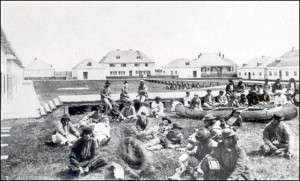Indian Agents skimmed resource revenue funds
When Britain stopped its £20,000 parliamentary grant to Canada, which had paid for the presents from the Queen and the administration of Indian Affairs in the late 1850s, most of the money to pay for the continuing administration of Indian Affairs came from the Indian Land Management Fund.
The capital of this Fund was established when the Department of Indian Affairs unilaterally took moneys from certain First Nation accounts, and then continued to add to this by taking an exorbitant 10% management fee from the proceeds of all First Nations land surrenders or on-Reserve developments.
An additional 6% was skimmed from the proceeds of ground rent or renewal fees in connection with timber development. These moneys formed the capital of the Management Fund, and the interest arising there was used to pay for the administration of Indian Affairs, primarily in Canada West and East, and then Ontario and Quebec. Before the turn of the 20th century, these same percentages were also skimmed from First Nation surrenders and developments in the west and the Maritimes.
The Indian Agents, including those on Lake Superior were often the front-line men collecting the 10% and 6% management fees on each transaction. Obviously, it was to the Department’s advantage to obtain as many surrenders from Reserves, or implement as many resource developments as possible because the percentages skimmed from these transactions paid the salaries and rents and many other expenses associated with Indian Affairs in Ottawa and in the field.
In addition, each Indian Agent was allowed to take 5% of the proceeds arising from these transactions as a personal fee for his management of the same. In total these fees, amounting in some cases to 21%, were deducted from revenues that could have accrued to First Nations.
Thus, we have the superstructure of the Department of Indian Affairs paid largely out of the interest account of the Indian Land Management Fund, and also sometimes out of the capital account when the interest account was deficient.
As we have already seen, some of the Indian Agents on Lake Superior were falsely charging the Department for travel expenses, or they charged for rent and never paid it. Travel, rent and other expenses associated with the field offices, including the one in Port Arthur – were paid from the Indian Land Management Fund. At the same time the Port Arthur Indian Agents were abusing these expenses, they were all the while being paid salaries from the Indian Land Management Fund. The Indian Land Management Fund was shut down during 1912/1913.
Ironically, not only were First Nations on Lake Superior paying for their own colonization by providing the money that was supposed to pay for virtually the entire operation of the Department of Indian Affairs in Ontario and Quebec, they were also paying the salaries, fees and expenses of the Indian Agents who were abusing those same moneys.
Dr. Rhonda Telford has been researching and writing land claims since 1985; she obtained her PhD from the University of Toronto in 1996, and has been working with the Union of Ontario Indians and others on land claims or land and Treaty issues since 1997.



